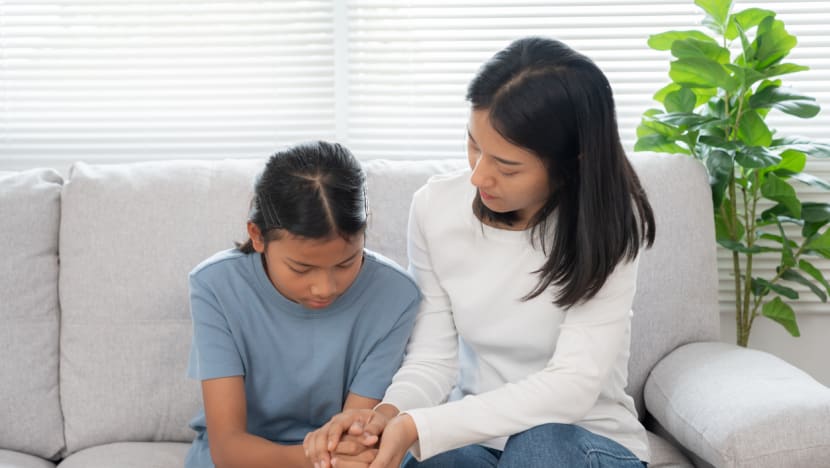Commentary: Why it's hard to have empathy during bullying incidents
Viral clips and soundbites of bullying are case studies for how quickly we rush to judgment on the internet, says educator and mother-of-three Emilia Idris.


This audio is generated by an AI tool.
SINGAPORE: When news broke online of a Primary 3 student sending a death threat to his classmate’s mother, it wasn’t the words that gripped my attention – it was the voice.
“I might dissect her … I will kill you and your husband.” These chilling words were delivered with the singsong lilt of a 9-year-old boy.
Such a brazen attitude to violence is not born overnight. It is learnt and normalised, perhaps through repeated exposure to the digital world.
Incidents of bullying seem to go viral every few months or so in Singapore recently. In February, a Montfort Secondary School student was filmed getting tripped and kicked by two schoolmates. In January, an Admiralty Secondary School student sustained a head wound after a classmate allegedly assaulted him. Police were involved in investigating both cases.
OUTRAGE AND ECHO CHAMBERS
Bullying makes for a good case study on how the digital world grips our emotions with fragments: a clip, a soundbite, a moment stripped of context. We rush to judgment. Outrage festers, echo chambers form, and soon it becomes us versus them.
The Sengkang Green Primary School case came to light because the mother of the affected student took to Facebook to share her experience of protecting her child who was bullied.
Online discussions about the case led to the doxxing of educators and young children. The Ministry of Education (MOE) then made public the facts of the case. Investigations revealed that the affected student had also engaged in “hurtful behaviours” towards others.
On Thursday (Aug 27), MOE said it will enhance school’s disciplinary frameworks and make reporting channels more accessible, as part of an ongoing review to better tackle bullying in schools.
As a parent, I can see why we would want to take matters into our own hands and court public support on social media, especially when there’s evidence to prove that our family is in danger. Bullying in any form, cannot be condoned, especially when one in four upper primary school students has suffered from it.
Children who are bullied are more likely to experience depression and anxiety, increased feelings of sadness and loneliness, changes in sleep and eating patterns, and loss of interest in activities they used to enjoy. These issues may persist into adulthood.
Empathy doesn’t excuse harmful behaviour, but it enables us to respond wisely, not react thoughtlessly. It asks us to slow down, to see beyond the surface and understand multiple perspectives and to recognise the person behind the words, no matter how flawed. That takes time – but time is something that the digital world rarely allows.
PARENTING IN A DIGITAL ERA
I have three children – 19, 15 and 10. When my older two were little, smartphones hadn’t taken over. Even then, the moment they got their first phones, my carefully nurtured reading routines evaporated overnight, replaced by chat groups and endless scrolling.
Still, they learnt to tell the difference between playful online banter and toxic exchanges, to know when to stick around and when it is time to “leave the room”.
My youngest, however, was born in a digital world. For him and many of his peers, smartphones are not tools, they are life. Education, play and friendships are all online.
It is easy to say that parents should teach kids how to navigate the digital world safely. But it can still be a scary place. Take online games, for instance. They seem harmless until suddenly, strangers start trash-talking your child. Their hurtful remarks can make a virtual space feel overwhelmingly real. Only a few will tell a trusted adult.
In Singapore, 74 per cent of internet users come across harmful content like cyberbullying, and are most likely to encounter it on social media compared to other platforms. If this is our children’s lived reality, it’s no wonder that they might be desensitised to violence and aggression, and even become bullies themselves.
Late in 2024, Australia announced a social media ban for children younger than 16 years old to ease school bullying and development issues. Many countries including Singapore are studying similar approaches. But this alone is not a sustainable solution. Parents and educators must prioritise soft skills – listening, empathy and the ability to handle nuance, rather than reducing everything to black and white.
BUILDING EMPATHY
The best advice I’ve read about bullying comes from renowned parenting educator Janet Lansbury.
Two children come to her – the “bully” and the “bullied”. To the bully, she focuses on maintaining calmness, not labelling and providing a non-judgmental safe space for “offloading”. To the bullied, she models composure and avoids overprotectiveness. She provides the mirror and guides them to take ownership of the situation.
The hardest part for me, as an adult, is step one – to remain calm. It is an instinct to be protective of our children. But anyone can be framed as a victim, and every “villain” has a backstory. If we can nurture empathy in our children, by perhaps modelling it ourselves, perhaps we can raise a generation that’s more gracious, resilient and understanding than ours.
The internet is not going away. But how our children grow within it – that, we can still shape.
Emilia Idris is Senior Lecturer at Centre for Educational Development, Republic Polytechnic, and a mother of three.


















